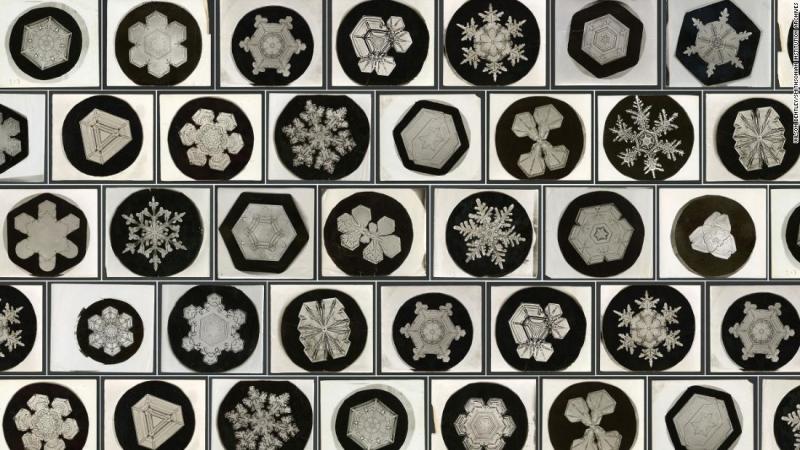How a Vermont farmer proved no snowflakes are alike
By: Kyle Almond (cnn)


No two snowflakes are alike... except for MAGA snowflakes, of course. They're all alike.
No trolls allowed! You know who you are.


Photographs by Wilson Bentley/Smithsonian Institution Archives
Story by Kyle Almond, CNN
Published December 23, 2022
No two snowflakes are alike. You probably learned that at an early age.
But you might not know the man who discovered it.
The lesson can be traced back to Wilson Bentley, a farmer from Jericho, Vermont, who in 1885 became the first person to successfully photograph an individual snow crystal — the ice that makes up snowflakes.
After years of trial and error, Bentley was able to capture the intricate details of snow crystals by using a compound microscope attached to his bellows camera. He went on to photograph more than 5,000 of these "ice flowers" during his lifetime — never finding any duplicates — and the images still mesmerize to this day.
Every snow crystal shares a common six-sided or six-pointed structure — it's how frozen water molecules arrange themselves — but they will always vary from one another because each falls from the sky in its own unique way and experiences slightly different atmospheric conditions on its travel down to earth.
Some of their arms may look long and skinny. Others may appear short and flat or somewhere in between. The possibilities are endless and fascinating.
"Under the microscope, I found that snowflakes were miracles of beauty; and it seemed a shame that this beauty should not be seen and appreciated by others," Bentley said in 1925. "Every crystal was a masterpiece of design, and no one design was ever repeated. When a snowflake melted, that design was forever lost. Just that much beauty was gone, without leaving any record behind."
Bentley eventually became known as "Snowflake" Bentley because of his life's work, and many of his photos can be seen today at the Old Red Mill, a historic landmark in Jericho.
The mill's Snowflake Bentley Exhibit also includes his cameras and microscopes.
"He had the mind of a scientist and the soul of a poet, and you can see that in his writings," said Sue Richardson, Bentley's great-grandniece who is vice president of the board for the Jericho Historical Society. "He wrote many, many articles over the years for scientific publications and for other magazines like Harper's Bazaar and National Geographic.
"He also kept very detailed weather records and very detailed journals of every photograph that he took of a snow crystal — the temperature, the humidity, what part of the storm it came from. He kept very detailed information, and then these weather records that he kept and the theories that he developed about how snow crystals formed in the atmosphere, those were proven true."
Richardson's grandmother was Bentley's favorite niece, Richardson said, and she had his cameras and other items that are now part of the exhibit.
"I grew up with this in my house and hearing the stories about Uncle Willie, as he was known within the family," Richardson said. "It's been a part of my life for as far back as I can remember."
Bentley never had any formal education, she said. His mother had been a schoolteacher prior to her marriage, so she taught Willie and his brother Charles at home.
"When he was 15, his mother had given him an old microscope from her teaching days," Richardson said. "And he looked at everything under it, from blades of grass and leaves and insects and flower petals and little pieces of rock. But the first time he looked at a snow crystal under it, he was hooked. Just the beauty, the intricate detail. He was totally hooked."
It wasn't easy, however, to get those snow crystals on camera. It took almost three years, Richardson said, for Bentley to figure out how to successfully photograph one — which he did just a month shy of his 20th birthday.
The first obstacle was figuring out how to attach the microscope to the camera. And then there was the challenge of getting each crystal photographed before it could melt away.
"He worked in an unheated woodshed at the back of the house. He had to," Richardson said. "And the microscope slides, everything, had to be an ambient temperature or they'd melt" the crystal.
Bentley would go outside with a wooden tray painted black and try to catch falling flakes. He would wear heavy mittens so the heat from his hands wouldn't transfer over. He would hold his breath as he used a broom straw to transfer the snow to the cold microscope slides. He would press the flakes down to the glass with a turkey feather. The light would come from only a little window in the woodshed.
"Of course, location is everything in this work, and no one except those living in arctic climates or in regions having long and severe winters can accomplish much," Bentley wrote in Popular Mechanics magazine in 1922.
Bentley died in 1931 at the age of 66, but his legacy lives on through his groundbreaking images that helped pave the way for generations of scientific photographers. In addition to the Jericho exhibit, many of his photos, as well as detailed records and journals, are part of the Smithsonian Institution Archives.
His images can also be found on prints, jewelry and Christmas ornaments. A children's book about him won the Caldecott Medal in 1999.
"It's fascinating that all these years later, people are still so captivated by his work," Richardson said. "You just grew up knowing that these snowflakes were these just delicate, beautiful things. And when you see the actual photographs, you go, 'Oh my gosh.' "





You will definitely want to look at the link to the seeded article to see all of the beautiful photos.
Here are a few --
Those are great photos
Where I live we don't have snow. You have to drive 2-3 hours up into the mountains to see any.
That is the best kind of snow ... the optional kind.
there's an xmas snow sale going on now in the front of my home. bring your wallet and a shovel...
That is cool.
The symmetry is what gets me.
I think the photos are amazing.
[deleted]
[deleted]
Some would suggest that each snowflake had a sentient designer.
yeah, whatever particulate the moisture was frozen to. hailstones are pretty interesting artistically also.
There would have to be whole armies of designers with all the snowflakes that fall every year. The estimate I read is at least 1 septillion in just the U.S.: 1,000,000,000,000,000,000,000,000 That's about 1 billion per second.
Or one very busy God.
[deleted]
Very cool, love all the beauty of the flakes as long as I don't have to live in it.
There are millions o unique flakes in this country.